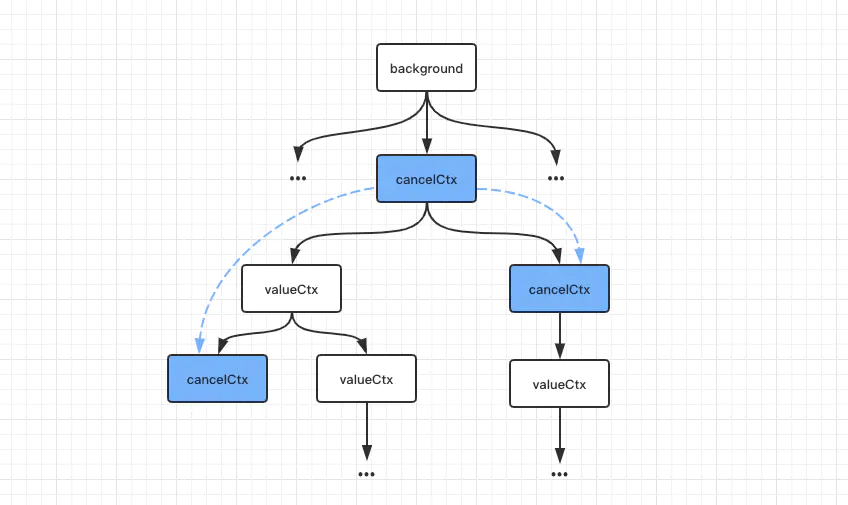深入理解 Golang 之 context
context是Go并发编程中常用到一种编程模式。本文将从为什么需要context,深入了解context的实现原理,以了解如何使用context。
作者:Turling_hu
来源: 掘金
前言
这篇文章将介绍Golang并发编程中常用到一种编程模式:context。本文将从为什么需要context出发,深入了解context的实现原理,以及了解如何使用context。
为什么需要context
在并发程序中,由于超时、取消操作或者一些异常情况,往往需要进行抢占操作或者中断后续操作。熟悉channel的朋友应该都见过使用done channel来处理此类问题。比如以下这个例子:
func main() {
messages := make(chan int, 10)
done := make(chan bool)
defer close(messages)
// consumer
go func() {
ticker := time.NewTicker(1 * time.Second)
for _ = range ticker.C {
select {
case <-done:
fmt.Println("child process interrupt...")
return
default:
fmt.Printf("send message: %d\n", <-messages)
}
}
}()
// producer
for i := 0; i < 10; i++ {
messages <- i
}
time.Sleep(5 * time.Second)
close(done)
time.Sleep(1 * time.Second)
fmt.Println("main process exit!")
}上述例子中定义了一个buffer为0的channel done, 子协程运行着定时任务。如果主协程需要在某个时刻发送消息通知子协程中断任务退出,那么就可以让子协程监听这个done channel,一旦主协程关闭done channel,那么子协程就可以推出了,这样就实现了主协程通知子协程的需求。这很好,但是这也是有限的。
如果我们可以在简单的通知上附加传递额外的信息来控制取消:为什么取消,或者有一个它必须要完成的最终期限,更或者有多个取消选项,我们需要根据额外的信息来判断选择执行哪个取消选项。
考虑下面这种情况:假如主协程中有多个任务1, 2, …m,主协程对这些任务有超时控制;而其中任务1又有多个子任务1, 2, …n,任务1对这些子任务也有自己的超时控制,那么这些子任务既要感知主协程的取消信号,也需要感知任务1的取消信号。
如果还是使用done channel的用法,我们需要定义两个done channel,子任务们需要同时监听这两个done channel。嗯,这样其实好像也还行哈。但是如果层级更深,如果这些子任务还有子任务,那么使用done channel的方式将会变得非常繁琐且混乱。
我们需要一种优雅的方案来实现这样一种机制:
- 上层任务取消后,所有的下层任务都会被取消;
- 中间某一层的任务取消后,只会将当前任务的下层任务取消,而不会影响上层的任务以及同级任务。
这个时候context就派上用场了。我们首先看看context的结构设计和实现原理。
context是什么
context接口
先看Context接口结构,看起来非常简单。
type Context interface {
Deadline() (deadline time.Time, ok bool)
Done() <-chan struct{}
Err() error
Value(key interface{}) interface{}
}Context接口包含四个方法:
Deadline返回绑定当前context的任务被取消的截止时间;如果没有设定期限,将返回ok == false。Done当绑定当前context的任务被取消时,将返回一个关闭的channel;如果当前context不会被取消,将返回nil。Err如果Done返回的channel没有关闭,将返回nil;如果Done返回的channel已经关闭,将返回非空的值表示任务结束的原因。如果是context被取消,Err将返回Canceled;如果是context超时,Err将返回DeadlineExceeded。Value返回context存储的键值对中当前key对应的值,如果没有对应的key,则返回nil。
可以看到Done方法返回的channel正是用来传递结束信号以抢占并中断当前任务;Deadline方法指示一段时间后当前goroutine是否会被取消;以及一个Err方法,来解释goroutine被取消的原因;而Value则用于获取特定于当前任务树的额外信息。而context所包含的额外信息键值对是如何存储的呢?其实可以想象一颗树,树的每个节点可能携带一组键值对,如果当前节点上无法找到key所对应的值,就会向上去父节点里找,直到根节点,具体后面会说到。
再来看看context包中的其他关键内容。
emptyCtx
emptyCtx是一个int类型的变量,但实现了context的接口。emptyCtx没有超时时间,不能取消,也不能存储任何额外信息,所以emptyCtx用来作为context树的根节点。
// An emptyCtx is never canceled, has no values, and has no deadline. It is not
// struct{}, since vars of this type must have distinct addresses.
type emptyCtx int
func (*emptyCtx) Deadline() (deadline time.Time, ok bool) {
return
}
func (*emptyCtx) Done() <-chan struct{} {
return nil
}
func (*emptyCtx) Err() error {
return nil
}
func (*emptyCtx) Value(key interface{}) interface{} {
return nil
}
func (e *emptyCtx) String() string {
switch e {
case background:
return "context.Background"
case todo:
return "context.TODO"
}
return "unknown empty Context"
}
var (
background = new(emptyCtx)
todo = new(emptyCtx)
)
func Background() Context {
return background
}
func TODO() Context {
return todo
}但我们一般不会直接使用emptyCtx,而是使用由emptyCtx实例化的两个变量,分别可以通过调用Background和TODO方法得到,但这两个context在实现上是一样的。那么Background和TODO方法得到的context有什么区别呢?可以看一下官方的解释:
// Background returns a non-nil, empty Context. It is never canceled, has no
// values, and has no deadline. It is typically used by the main function,
// initialization, and tests, and as the top-level Context for incoming
// requests.
// TODO returns a non-nil, empty Context. Code should use context.TODO when
// it's unclear which Context to use or it is not yet available (because the
// surrounding function has not yet been extended to accept a Context
// parameter).Background和TODO只是用于不同场景下:Background通常被用于主函数、初始化以及测试中,作为一个顶层的context,也就是说一般我们创建的context都是基于Background;而TODO是在不确定使用什么context的时候才会使用。
下面将介绍两种不同功能的基础context类型:valueCtx和cancelCtx。
valueCtx
valueCtx结构体
type valueCtx struct {
Context
key, val interface{}
}
func (c *valueCtx) Value(key interface{}) interface{} {
if c.key == key {
return c.val
}
return c.Context.Value(key)
}valueCtx利用一个Context类型的变量来表示父节点context,所以当前context继承了父context的所有信息;valueCtx类型还携带一组键值对,也就是说这种context可以携带额外的信息。valueCtx实现了Value方法,用以在context链路上获取key对应的值,如果当前context上不存在需要的key,会沿着context链向上寻找key对应的值,直到根节点。
WithValue
WithValue用以向context添加键值对:
func WithValue(parent Context, key, val interface{}) Context {
if key == nil {
panic("nil key")
}
if !reflect.TypeOf(key).Comparable() {
panic("key is not comparable")
}
return &valueCtx{parent, key, val}
}这里添加键值对不是在原context结构体上直接添加,而是以此context作为父节点,重新创建一个新的valueCtx子节点,将键值对添加在子节点上,由此形成一条context链。获取value的过程就是在这条context链上由尾部上前搜寻:

cancelCtx
cancelCtx结构体
type cancelCtx struct {
Context
mu sync.Mutex // protects following fields
done chan struct{} // created lazily, closed by first cancel call
children map[canceler]struct{} // set to nil by the first cancel call
err error // set to non-nil by the first cancel call
}
type canceler interface {
cancel(removeFromParent bool, err error)
Done() <-chan struct{}
}跟valueCtx类似,cancelCtx中也有一个context变量作为父节点;变量done表示一个channel,用来表示传递关闭信号;children表示一个map,存储了当前context节点下的子节点;err用于存储错误信息表示任务结束的原因。
再来看一下cancelCtx实现的方法:
func (c *cancelCtx) Done() <-chan struct{} {
c.mu.Lock()
if c.done == nil {
c.done = make(chan struct{})
}
d := c.done
c.mu.Unlock()
return d
}
func (c *cancelCtx) Err() error {
c.mu.Lock()
err := c.err
c.mu.Unlock()
return err
}
func (c *cancelCtx) cancel(removeFromParent bool, err error) {
if err == nil {
panic("context: internal error: missing cancel error")
}
c.mu.Lock()
if c.err != nil {
c.mu.Unlock()
return // already canceled
}
// 设置取消原因
c.err = err
设置一个关闭的channel或者将done channel关闭,用以发送关闭信号
if c.done == nil {
c.done = closedchan
} else {
close(c.done)
}
// 将子节点context依次取消
for child := range c.children {
// NOTE: acquiring the child's lock while holding parent's lock.
child.cancel(false, err)
}
c.children = nil
c.mu.Unlock()
if removeFromParent {
// 将当前context节点从父节点上移除
removeChild(c.Context, c)
}
}可以发现cancelCtx类型变量其实也是canceler类型,因为cancelCtx实现了canceler接口。Done方法和Err方法没必要说了,cancelCtx类型的context在调用cancel方法时会设置取消原因,将done channel设置为一个关闭channel或者关闭channel,然后将子节点context依次取消,如果有需要还会将当前节点从父节点上移除。
WithCancel
WithCancel函数用来创建一个可取消的context,即cancelCtx类型的context。WithCancel返回一个context和一个CancelFunc,调用CancelFunc即可触发cancel操作。直接看源码:
type CancelFunc func()
func WithCancel(parent Context) (ctx Context, cancel CancelFunc) {
c := newCancelCtx(parent)
propagateCancel(parent, &c)
return &c, func() { c.cancel(true, Canceled) }
}
// newCancelCtx returns an initialized cancelCtx.
func newCancelCtx(parent Context) cancelCtx {
// 将parent作为父节点context生成一个新的子节点
return cancelCtx{Context: parent}
}
func propagateCancel(parent Context, child canceler) {
if parent.Done() == nil {
// parent.Done()返回nil表明父节点以上的路径上没有可取消的context
return // parent is never canceled
}
// 获取最近的类型为cancelCtx的祖先节点
if p, ok := parentCancelCtx(parent); ok {
p.mu.Lock()
if p.err != nil {
// parent has already been canceled
child.cancel(false, p.err)
} else {
if p.children == nil {
p.children = make(map[canceler]struct{})
}
// 将当前子节点加入最近cancelCtx祖先节点的children中
p.children[child] = struct{}{}
}
p.mu.Unlock()
} else {
go func() {
select {
case <-parent.Done():
child.cancel(false, parent.Err())
case <-child.Done():
}
}()
}
}
func parentCancelCtx(parent Context) (*cancelCtx, bool) {
for {
switch c := parent.(type) {
case *cancelCtx:
return c, true
case *timerCtx:
return &c.cancelCtx, true
case *valueCtx:
parent = c.Context
default:
return nil, false
}
}
}之前说到cancelCtx取消时,会将后代节点中所有的cancelCtx都取消,propagateCancel即用来建立当前节点与祖先节点这个取消关联逻辑。
- 如果
parent.Done()返回nil,表明父节点以上的路径上没有可取消的context,不需要处理; - 如果在
context链上找到到cancelCtx类型的祖先节点,则判断这个祖先节点是否已经取消,如果已经取消就取消当前节点;否则将当前节点加入到祖先节点的children列表。 - 否则开启一个协程,监听
parent.Done()和child.Done(),一旦parent.Done()返回的channel关闭,即context链中某个祖先节点context被取消,则将当前context也取消。
这里或许有个疑问,为什么是祖先节点而不是父节点?这是因为当前context链可能是这样的:

当前cancelCtx的父节点context并不是一个可取消的context,也就没法记录children。
timerCtx
timerCtx是一种基于cancelCtx的context类型,从字面上就能看出,这是一种可以定时取消的context。
type timerCtx struct {
cancelCtx
timer *time.Timer // Under cancelCtx.mu.
deadline time.Time
}
func (c *timerCtx) Deadline() (deadline time.Time, ok bool) {
return c.deadline, true
}
func (c *timerCtx) cancel(removeFromParent bool, err error) {
将内部的cancelCtx取消
c.cancelCtx.cancel(false, err)
if removeFromParent {
// Remove this timerCtx from its parent cancelCtx's children.
removeChild(c.cancelCtx.Context, c)
}
c.mu.Lock()
if c.timer != nil {
取消计时器
c.timer.Stop()
c.timer = nil
}
c.mu.Unlock()
}timerCtx内部使用cancelCtx实现取消,另外使用定时器timer和过期时间deadline实现定时取消的功能。timerCtx在调用cancel方法,会先将内部的cancelCtx取消,如果需要则将自己从cancelCtx祖先节点上移除,最后取消计时器。
WithDeadline
WithDeadline返回一个基于parent的可取消的context,并且其过期时间deadline不晚于所设置时间d。
func WithDeadline(parent Context, d time.Time) (Context, CancelFunc) {
if cur, ok := parent.Deadline(); ok && cur.Before(d) {
// The current deadline is already sooner than the new one.
return WithCancel(parent)
}
c := &timerCtx{
cancelCtx: newCancelCtx(parent),
deadline: d,
}
// 建立新建context与可取消context祖先节点的取消关联关系
propagateCancel(parent, c)
dur := time.Until(d)
if dur <= 0 {
c.cancel(true, DeadlineExceeded) // deadline has already passed
return c, func() { c.cancel(false, Canceled) }
}
c.mu.Lock()
defer c.mu.Unlock()
if c.err == nil {
c.timer = time.AfterFunc(dur, func() {
c.cancel(true, DeadlineExceeded)
})
}
return c, func() { c.cancel(true, Canceled) }
}- 如果父节点
parent有过期时间并且过期时间早于给定时间d,那么新建的子节点context无需设置过期时间,使用WithCancel创建一个可取消的context即可; - 否则,就要利用
parent和过期时间d创建一个定时取消的timerCtx,并建立新建context与可取消context祖先节点的取消关联关系,接下来判断当前时间距离过期时间d的时长dur:
- 如果
dur小于0,即当前已经过了过期时间,则直接取消新建的timerCtx,原因为DeadlineExceeded; - 否则,为新建的
timerCtx设置定时器,一旦到达过期时间即取消当前timerCtx。
WithTimeout
与WithDeadline类似,WithTimeout也是创建一个定时取消的context,只不过WithDeadline是接收一个过期时间点,而WithTimeout接收一个相对当前时间的过期时长timeout:
func WithTimeout(parent Context, timeout time.Duration) (Context, CancelFunc) {
return WithDeadline(parent, time.Now().Add(timeout))
}context的使用
首先使用context实现文章开头done channel的例子来示范一下如何更优雅实现协程间取消信号的同步:
func main() {
messages := make(chan int, 10)
// producer
for i := 0; i < 10; i++ {
messages <- i
}
ctx, cancel := context.WithTimeout(context.Background(), 5*time.Second)
// consumer
go func(ctx context.Context) {
ticker := time.NewTicker(1 * time.Second)
for _ = range ticker.C {
select {
case <-ctx.Done():
fmt.Println("child process interrupt...")
return
default:
fmt.Printf("send message: %d\n", <-messages)
}
}
}(ctx)
defer close(messages)
defer cancel()
select {
case <-ctx.Done():
time.Sleep(1 * time.Second)
fmt.Println("main process exit!")
}
}这个例子中,只要让子线程监听主线程传入的ctx,一旦ctx.Done()返回空channel,子线程即可取消执行任务。但这个例子还无法展现context的传递取消信息的强大优势。
阅读过net/http包源码的朋友可能注意到在实现http server时就用到了context, 下面简单分析一下。
1、首先Server在开启服务时会创建一个valueCtx,存储了server的相关信息,之后每建立一条连接就会开启一个协程,并携带此valueCtx。
func (srv *Server) Serve(l net.Listener) error {
...
var tempDelay time.Duration // how long to sleep on accept failure
baseCtx := context.Background() // base is always background, per Issue 16220
ctx := context.WithValue(baseCtx, ServerContextKey, srv)
for {
rw, e := l.Accept()
...
tempDelay = 0
c := srv.newConn(rw)
c.setState(c.rwc, StateNew) // before Serve can return
go c.serve(ctx)
}
}2、建立连接之后会基于传入的context创建一个valueCtx用于存储本地地址信息,之后在此基础上又创建了一个cancelCtx,然后开始从当前连接中读取网络请求,每当读取到一个请求则会将该cancelCtx传入,用以传递取消信号。一旦连接断开,即可发送取消信号,取消所有进行中的网络请求。
func (c *conn) serve(ctx context.Context) {
c.remoteAddr = c.rwc.RemoteAddr().String()
ctx = context.WithValue(ctx, LocalAddrContextKey, c.rwc.LocalAddr())
...
ctx, cancelCtx := context.WithCancel(ctx)
c.cancelCtx = cancelCtx
defer cancelCtx()
...
for {
w, err := c.readRequest(ctx)
...
serverHandler{c.server}.ServeHTTP(w, w.req)
...
}
}3、读取到请求之后,会再次基于传入的context创建新的cancelCtx,并设置到当前请求对象req上,同时生成的response对象中cancelCtx保存了当前context取消方法。
func (c *conn) readRequest(ctx context.Context) (w *response, err error) {
...
req, err := readRequest(c.bufr, keepHostHeader)
...
ctx, cancelCtx := context.WithCancel(ctx)
req.ctx = ctx
...
w = &response{
conn: c,
cancelCtx: cancelCtx,
req: req,
reqBody: req.Body,
handlerHeader: make(Header),
contentLength: -1,
closeNotifyCh: make(chan bool, 1),
// We populate these ahead of time so we're not
// reading from req.Header after their Handler starts
// and maybe mutates it (Issue 14940)
wants10KeepAlive: req.wantsHttp10KeepAlive(),
wantsClose: req.wantsClose(),
}
...
return w, nil
}这样处理的目的主要有以下几点:
- 一旦请求超时,即可中断当前请求;
- 在处理构建
response过程中如果发生错误,可直接调用response对象的cancelCtx方法结束当前请求; - 在处理构建
response完成之后,调用response对象的cancelCtx方法结束当前请求。
在整个server处理流程中,使用了一条context链贯穿Server、Connection、Request,不仅将上游的信息共享给下游任务,同时实现了上游可发送取消信号取消所有下游任务,而下游任务自行取消不会影响上游任务。
总结
context主要用于父子任务之间的同步取消信号,本质上是一种协程调度的方式。另外在使用context时有两点值得注意:上游任务仅仅使用context通知下游任务不再需要,但不会直接干涉和中断下游任务的执行,由下游任务自行决定后续的处理操作,也就是说context的取消操作是无侵入的;context是线程安全的,因为context本身是不可变的(immutable),因此可以放心地在多个协程中传递使用。
参考资料
2、Go Concurrency Patterns: Context
3、Understanding the context package in golang

本作品采用《CC 协议》,转载必须注明作者和本文链接



 关于 LearnKu
关于 LearnKu




推荐文章: